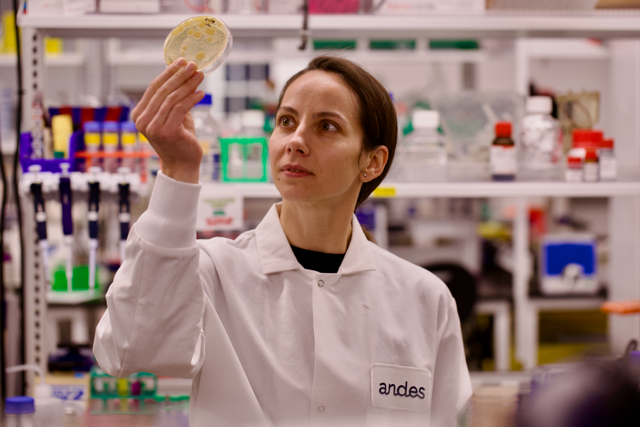
Some of the microbes that make carbon sequestration work.
Andes Ag, Inc
In 2022, humans emitted a staggering 36 gigatons of carbon dioxide into the atmosphere. Along with reducing emissions, removing carbon dioxide from the atmosphere is a key climate mitigation strategy. But Gonzalo Fuenzalida wasn’t looking to help solve climate change when he co-founded the US company Andes.
“We started this company with the idea of using microbes to make the process of growing food more resilient,” says Fuenzalida. “We stumbled upon these microbes that have the ability to create minerals in the soil which contain carbon, and that intrigued us.”
Fuenzalida, alongside his co-founder Tania Timmermann-Aranis, had an unconventional notion: They could harness the power of microbes residing in plant roots within the soil to remove carbon from the atmosphere. These naturally occurring microbes can be applied to the soil by blending them with pesticides or other soil treatments—they will strategically position themselves within the root structure of corn, wheat, and soy plants.
Making minerals
Once embedded within the root structure, the microbes aid in carbon dioxide removal via a three-step process. First, the microbe aids in turning carbon dioxide from the roots, combined with water from the soil, into bicarbonate ions and protons. Second, it accelerates a natural process known as silicate mineral weathering, which takes silicate minerals—one of the most common soil components—and uses protons (generated in the first step) to strip a positively charged ion, such as a calcium ion, from the mineral. Third, the microbe induces precipitation of carbonate minerals by creating an environment that favors combining the cations generated in the second step with the bicarbonate generated in the first step. These carbonate minerals remain stable for thousands of years, trapping the carbon dioxide. Over the years, the minerals percolate through the soil to the water table and eventually get flushed into rivers and oceans.
Andes collaborates with farmers, providing them with the microbes to incorporate into their existing soil treatments. Importantly, Fuenzalida says the use of Andes’ microbes not only contributes to carbon capture but also proves to be mutually beneficial for the soil and farmers. The microbes enhance soil health, improving crop yields. Andes also uses carbon offsets purchased by environmentally conscious companies to compensate farmers for each acre where the microbes are applied, offering an additional incentive for farmers to participate.
“Most of the focus is on being able to become carbon neutral, but it’s also important what impact you have on people and their communities,” Fuenzalida says. “We also have a very tangible impact because we do cash payments to the farmers participating in the program every year. In the near future, we are planning expansion into South America and also Africa at some point, and being able to have this dual impact is something that is a true driver for us.”
Offsetting emissions
For now, this carbon offset option is on the expensive side: more than $100 per tonne of carbon dioxide removed. Andes is working on lowering that cost as they scale up production—the biggest limit right now is simply growing enough of the bacteria needed to supply farms. Last year, the company went from supplying enough bacteria to treat 25,000 acres (in the Midwest) to handling 50,000 acres, and they say there’s farmer demand for 250,000 more.
At best, this can only partially solve our excessive carbon emissions. The microbes contribute to the removal of between 1 and 3 tonnes of carbon dioxide per acre. So, to get to the gigaton scale and make a dent in our current carbon dioxide output, they would have to expand to all available farmland suitable for this strategy—around 400 million acres. Even then, removing more than 1 gigaton of carbon dioxide with this technique would be a challenge.
“There’s no silver bullet,” Fuenzalida says. “It needs to be a combination of technologies, and I truly think that ours will become one of the leaders in that area.”
Dina Genkina is a freelance science writer and podcaster based in Brooklyn, New York, and a science communicator at the Joint Quantum Institute. She’s interested in quantum physics, AI, climate tech, and other cool things.





